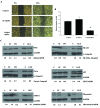The mushroom Ganoderma lucidum suppresses breast-to-lung cancer metastasis through the inhibition of pro-invasive genes
- PMID: 24718855
- PMCID: PMC4735696
- DOI: 10.3892/ijo.2014.2375
The mushroom Ganoderma lucidum suppresses breast-to-lung cancer metastasis through the inhibition of pro-invasive genes
Abstract
Breast cancer metastasis is one of the major reasons for the high morbidity and mortality of breast cancer patients. In spite of surgical interventions, chemotherapy, radiation therapy and targeted therapy, some patients are considering alternative therapies with herbal/natural products. In the present study, we evaluated a well-characterized extract from the medicinal mushroom Ganoderma lucidum (GLE) for its affects on tumor growth and breast-to-lung cancer metastasis. MDA-MB-231 human breast cancer cells were implanted into the mammary fat pads of nude mice. GLE (100 mg/kg/every other day) was administered to the mice by an oral gavage for 4 weeks, and tumor size was measured using microcalipers. Lung metastases were evaluated by hematoxylin and eosin (H&E) staining. Gene expression in MDA-MB-231 cells was determined by DNA microarray analysis and confirmed by quantitative PCR. Identified genes were silenced by siRNA, and cell migration was determined in Boyden chambers and by wound-healing assay. Although an oral administration of GLE only slightly suppressed the growth of large tumors, the same treatment significantly inhibited the number of breast-to-lung cancer metastases. GLE also downregulated the expression of genes associated with invasive behavior (HRAS, VIL2, S100A4, MCAM, I2PP2A and FN1) in MDA-MB-231 cells. Gene silencing of HRAS, VIL2, S100A4, I2PP2A and FN1 by siRNA suppressed migration of MDA-MB‑231 cells. Our study suggests that an oral administration of GLE can inhibit breast-to-lung cancer metastases through the downregulation of genes responsible for cell invasiveness. The anti-metastatic benefits of GLE warrant further clinical studies.
Figures




References
-
- Jemal A, Bray F, Center MM, Ferlay J, Ward E, Forman D. Global cancer statistics. CA Cancer J Clin. 2011;61:69–90. - PubMed
-
- Jemal A, Siegel R, Xu J, Ward E. Cancer statistics, 2010. CA Cancer J Clin. 2010;60:277–300. - PubMed
-
- Christofori G. New signals from the invasive front. Nature. 2006;441:444–450. - PubMed
-
- Gullett NP, Ruhul Amin AR, Bayraktar S, et al. Cancer prevention with natural compounds. Semin Oncol. 2010;37:258–281. - PubMed
-
- Zhang M, Huang J, Xie X, Holman CD. Dietary intakes of mushrooms and green tea combine to reduce the risk of breast cancer in Chinese women. Int J Cancer. 2009;124:1404–1408. - PubMed
Publication types
MeSH terms
Substances
Grants and funding
LinkOut - more resources
Full Text Sources
Other Literature Sources
Medical
Research Materials
Miscellaneous

